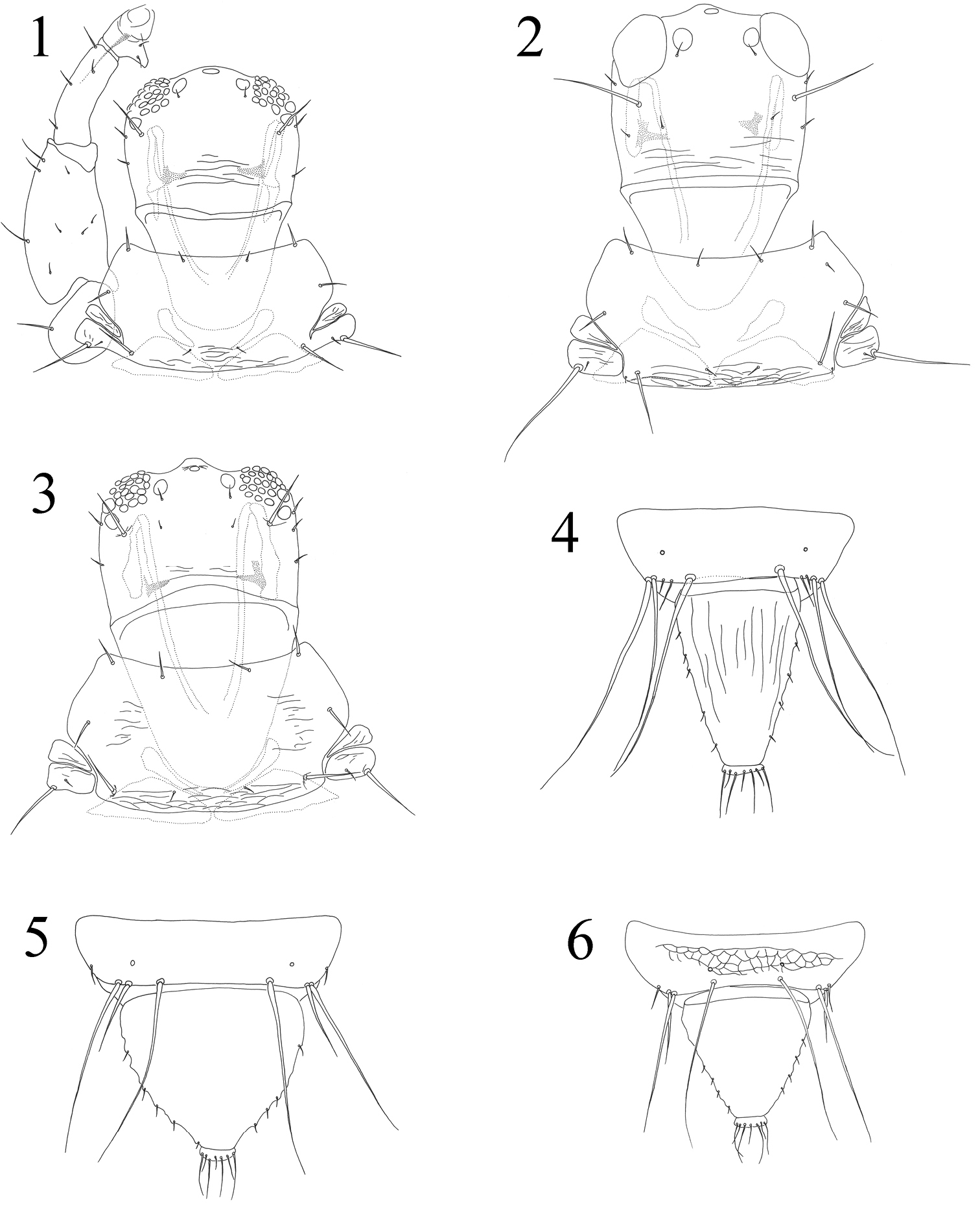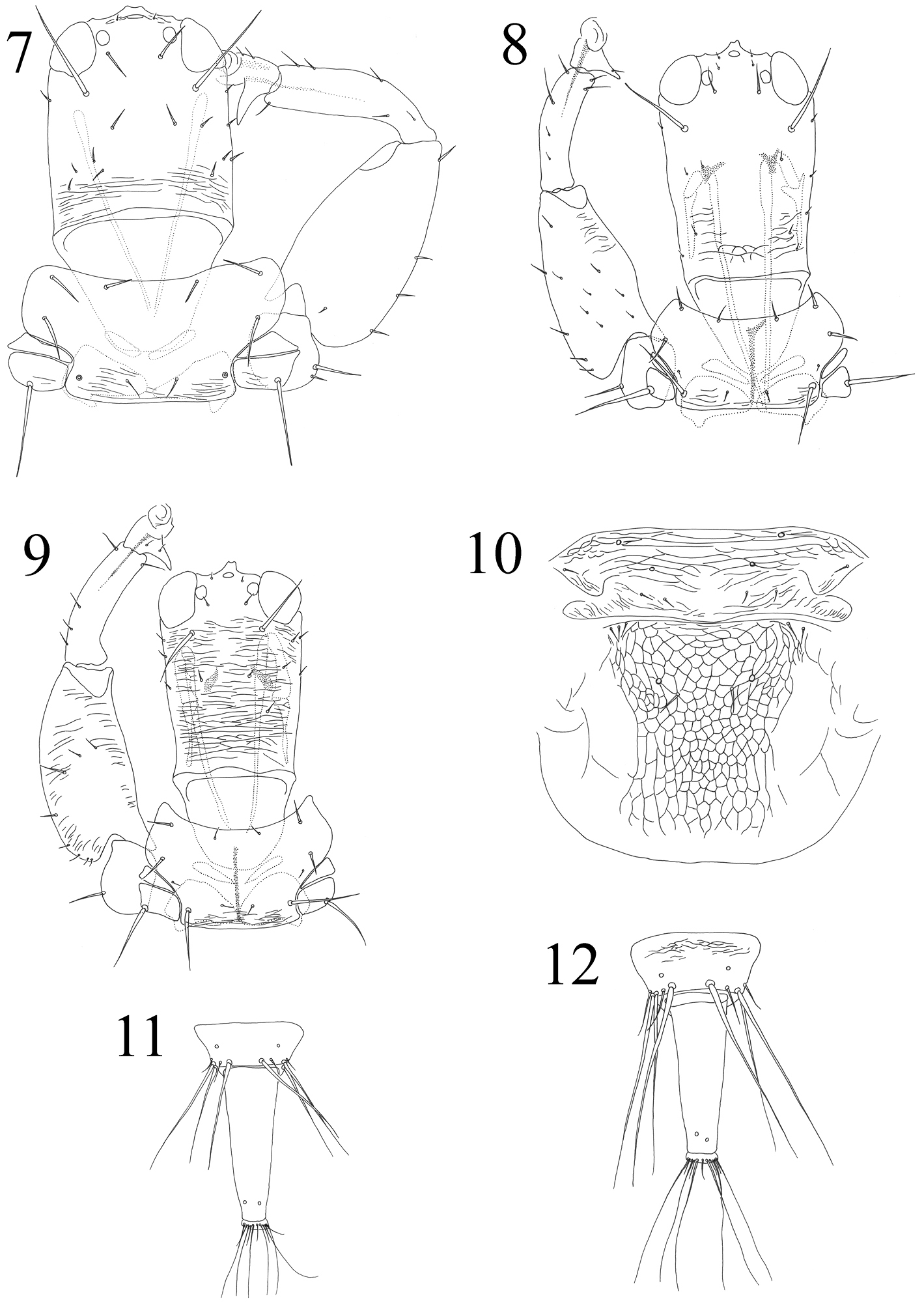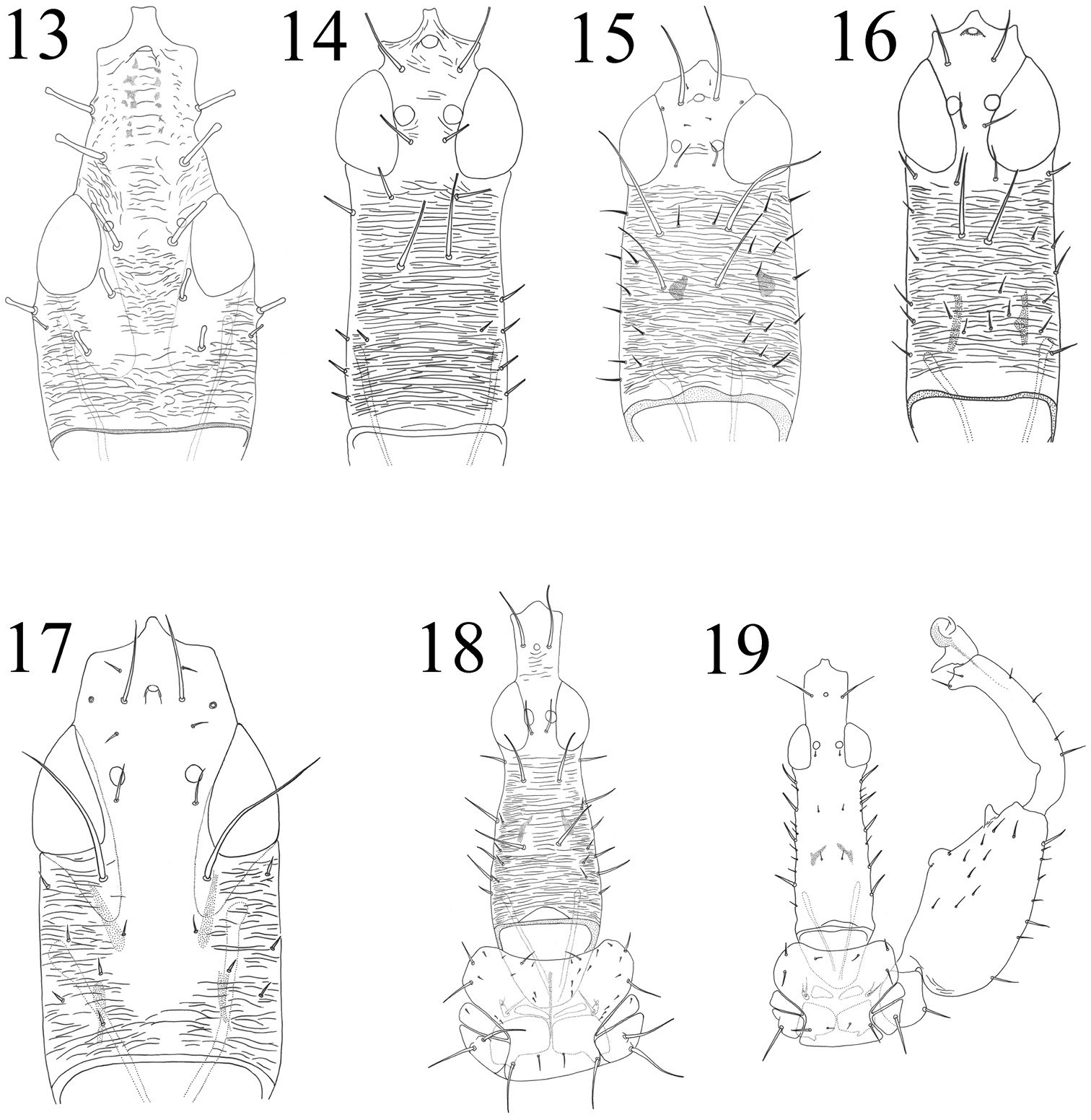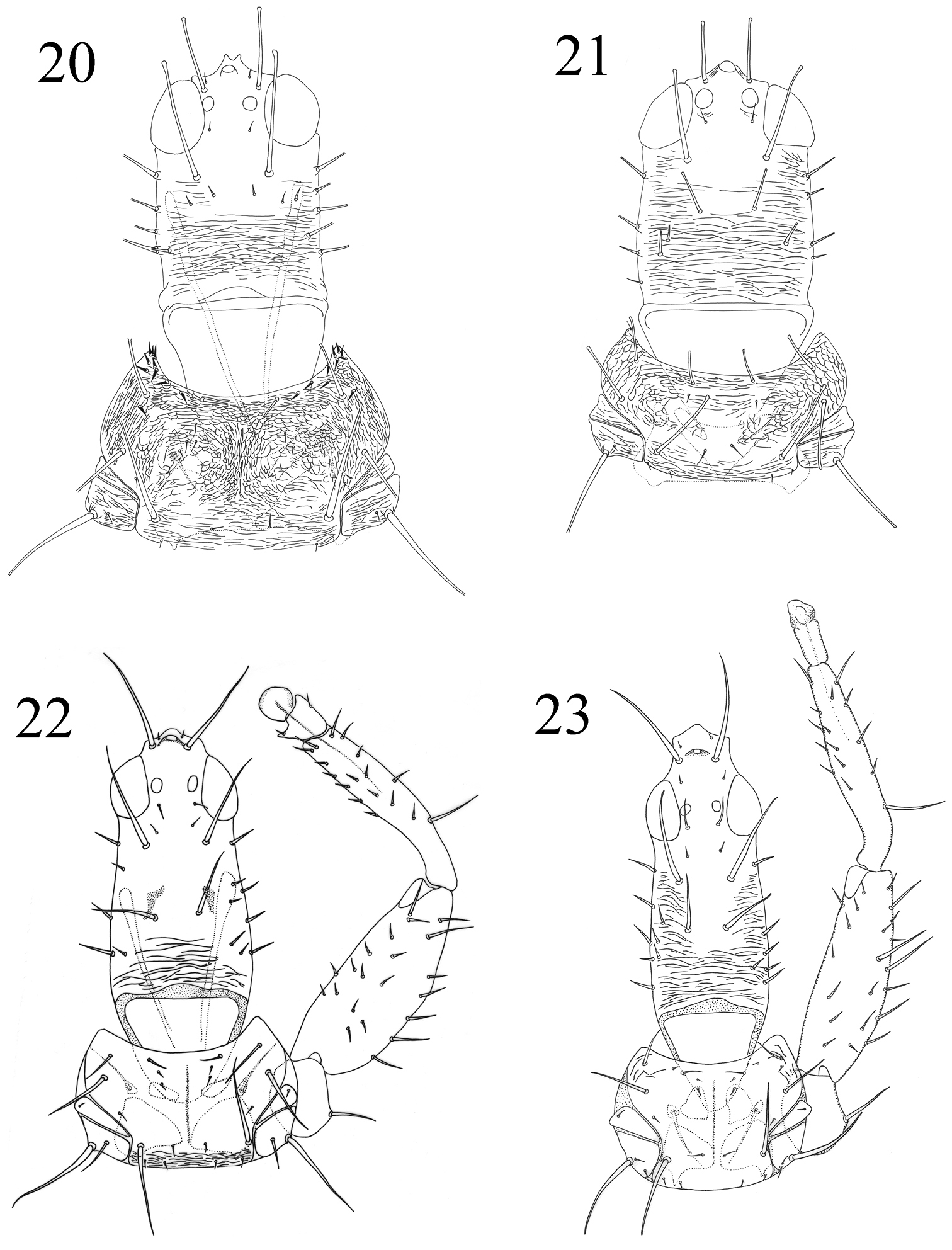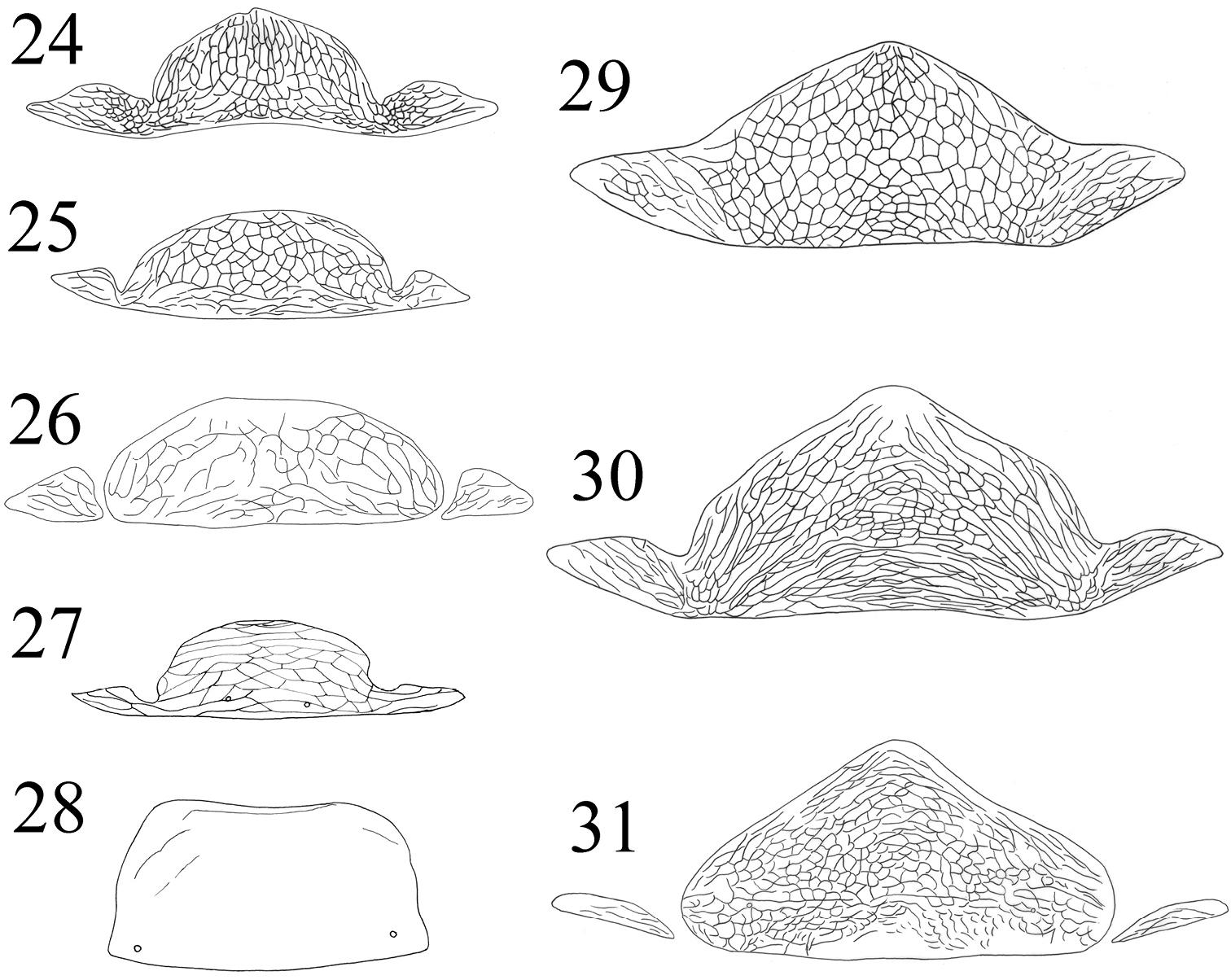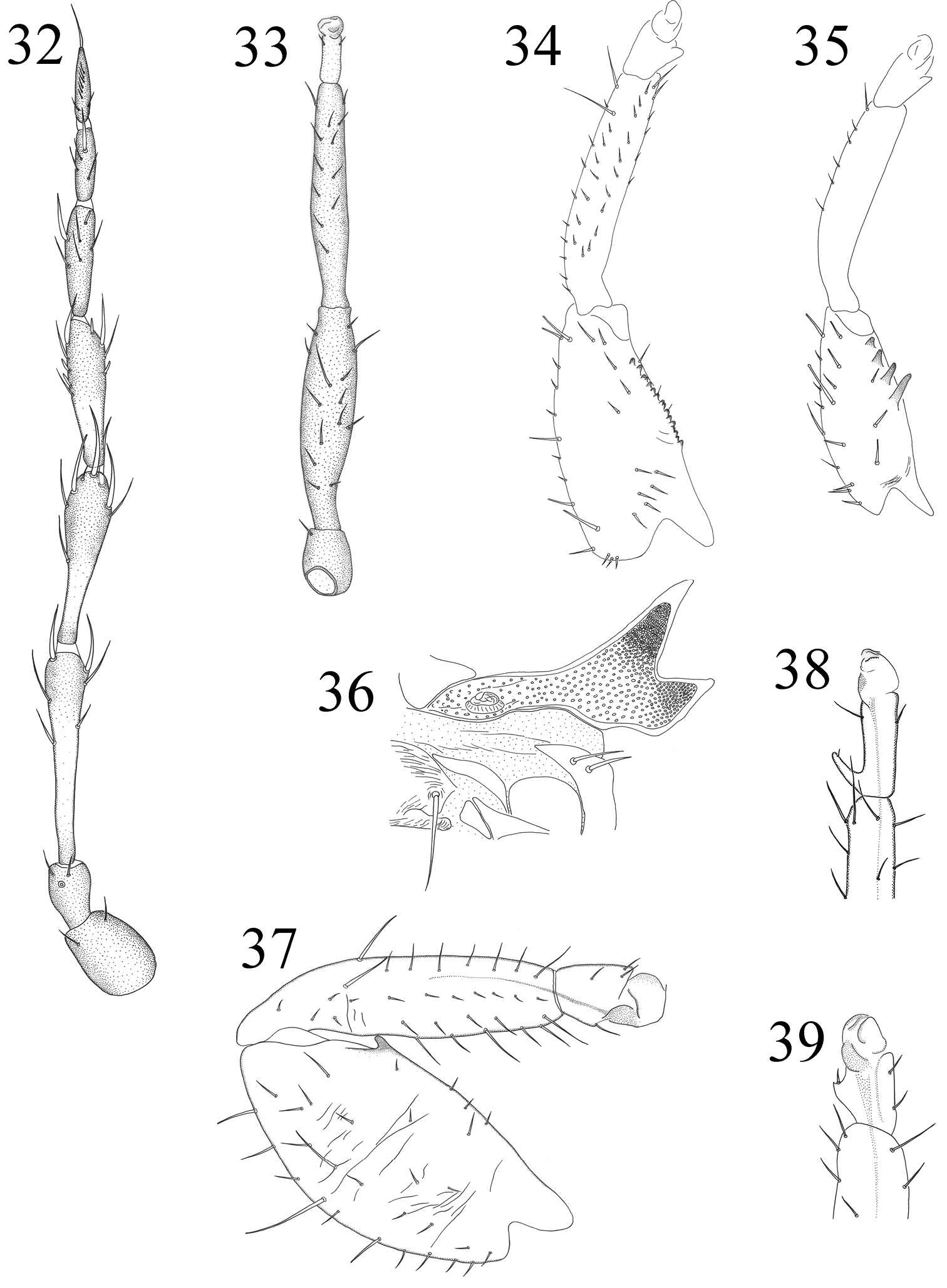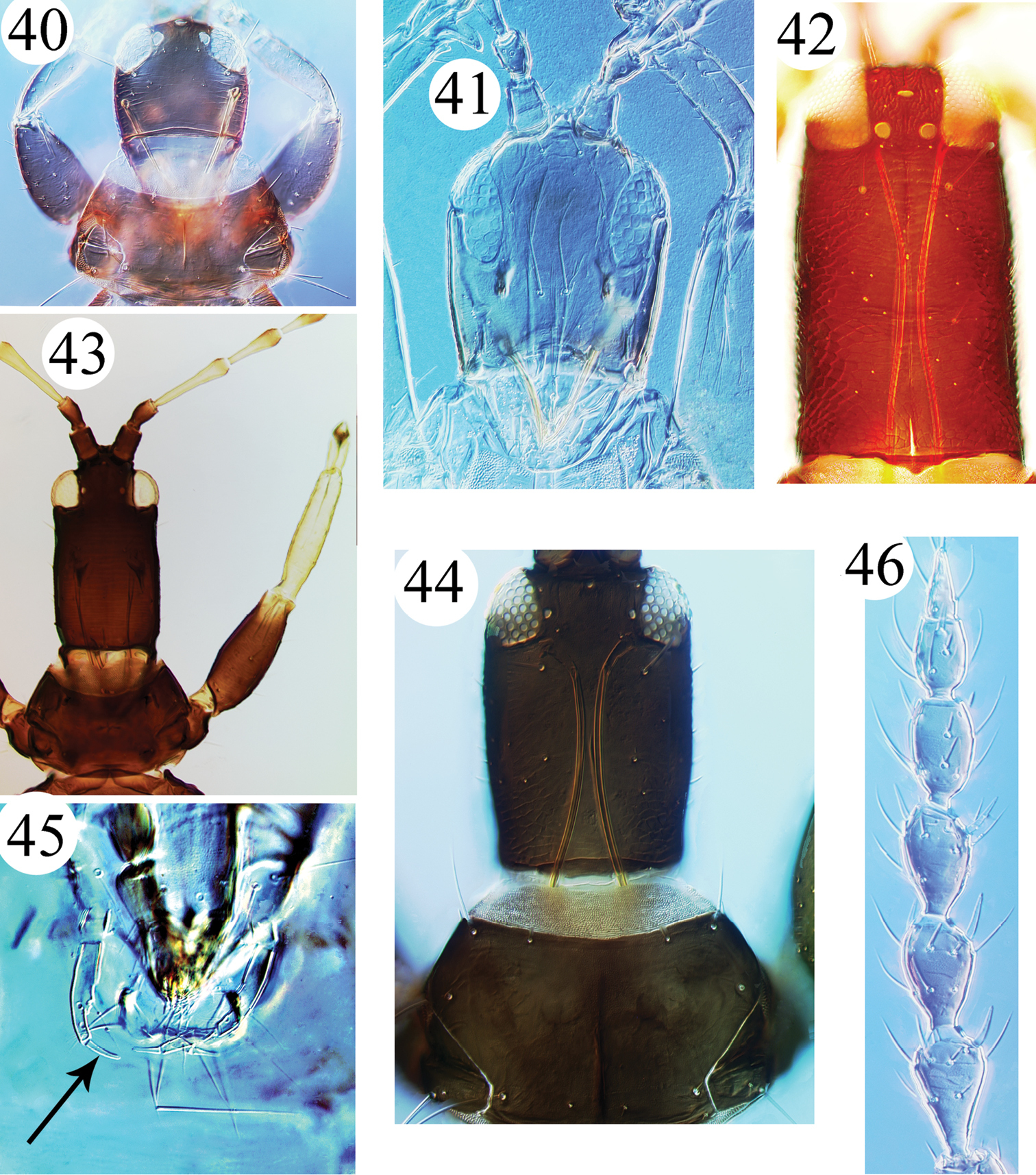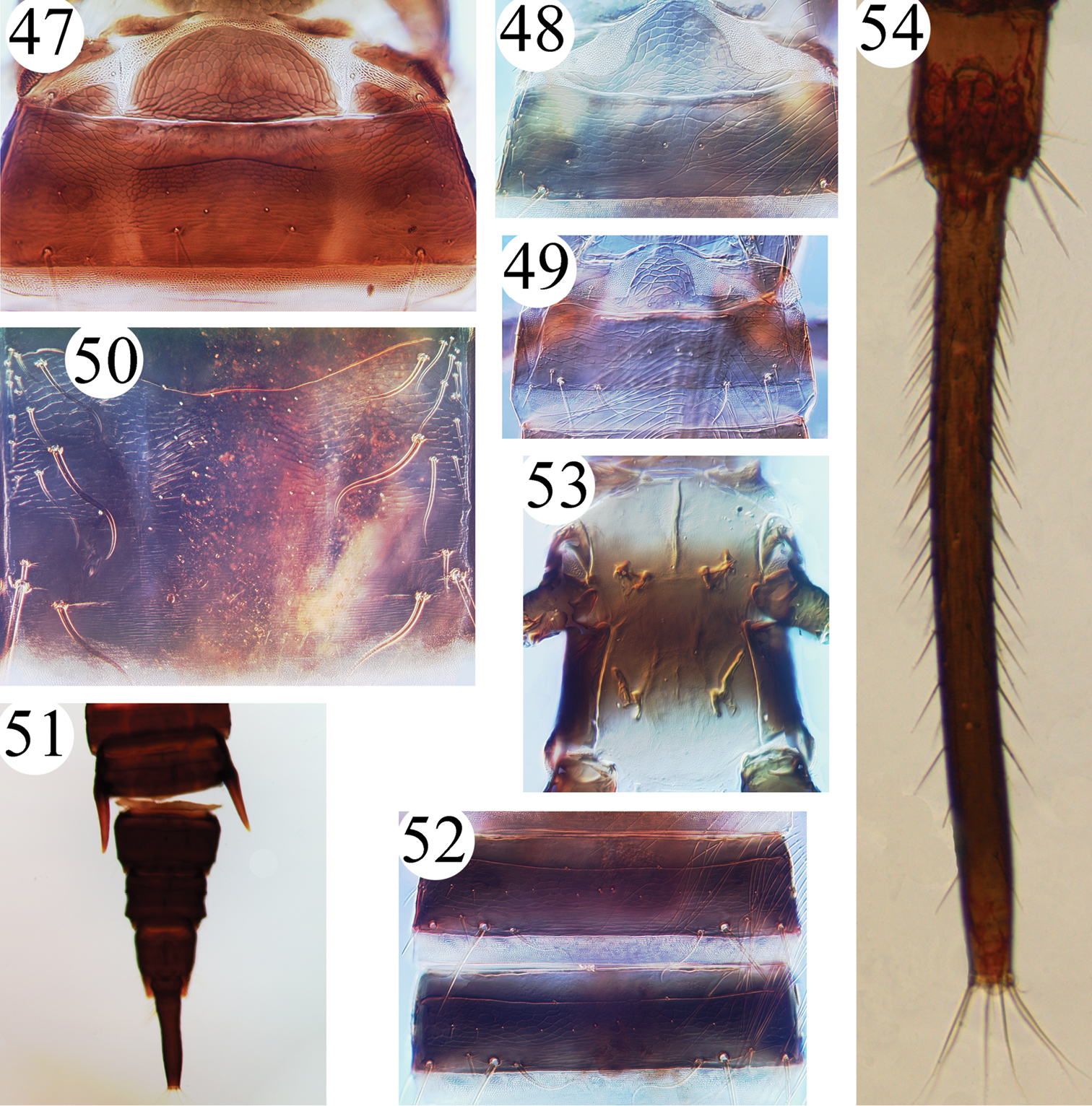






(C) 2013 Li-Hong Dang. This is an open access article distributed under the terms of the Creative Commons Attribution License 3.0 (CC-BY), which permits unrestricted use, distribution, and reproduction in any medium, provided the original author and source are credited.
For reference, use of the paginated PDF or printed version of this article is recommended.
Citation: Dang L-H, Qiao G-X (2013) Review of the spore-feeding Idolothripinae from China (Thysanoptera, Phlaeothripidae). ZooKeys 345: 1–28. doi: 10.3897/zookeys.345.6167
An illustrated key is provided to the 19 genera of the subfamily Idolothripinae from China, and a checklist given to 62 named species, of which six species are newly recorded from China, together with the genus Bolothrips that is represented by two un-named species. A generic diagnosis is given for each genus, along with some discussion of systematic relationship problems and species diversity. Identification keys to species of 11 genera are provided, and Megathrips antennatus Guo, Feng & Duan is considered as a new synonymof Megathrips lativentris (Heeger).
Idolothripinae, genera, illustrated keys, species checklist, new records, China
The insect order Thysanoptera, comprises more than 6000 species, and is classified into two suborders, Terebrantia and Tubulifera (
The present work, as part of ongoing studies on the Phlaeothripidae from China, aims at providing an identification key to the 19 genera and 62 species of Idolothripinae now recorded from China. A species checklist is included, with distributional information based on the provinces and autonomous regions of China (Table 1), and a diagnosis is provided for each genus. The genus Bolothrips is here newly recorded from China, and six species of Idolothripinae are also newly recorded (Table 1). Moreover, Megathrips antennatus Guo, Feng & Duan is here considered as a new synonym of Megathrips lativentris (Heeger).
Idolothripinae recorded from China.
| Taxa | Distribution in China by Provinces or Autonomous Regions |
|---|---|
| Acallurothrips casuarinae Okajima, 1993 | Taiwan |
| Acallurothrips hagai Okajima, 1993 | Taiwan |
| Acallurothrips nonakai Okajima, 1993 | Taiwan |
| Acallurothrips tubullatus Wang & Tong, 2008 | Guangdong |
| Allothrips bicolor Ananthakrishnan, 1964 | Hainan |
| Allothrips discolor Chen, 1982 | Taiwan |
| Allothrips taiwanus Okajima, 1987 | Taiwan |
| Bactrothrips brevitubus Takahashi, 1935 | Southern China |
| Bactrothrips elongates Dang & Qiao, 2012 | Guangxi |
| Bactrothrips flectoventris Haga & Okajima, 1989 | Hainan |
| Bactrothrips furvescrus Dang & Qiao, 2012 | Zhejiang |
| Bactrothrips honoris (Bagnall, 1921) | Guangxi; Yunnan |
| Bactrothrips pictipes Haga & Okajima, 1989 | Tibet; Guangxi; Hainan |
| Bactrothrips quadrituberculatus (Bagnall, 1908) | Yunnan; Hainan |
| Beijing; Inner Mongolia | |
| Compsothrips reticulates Guo & Feng, 2006 | Hebei |
| Compsothrips sinensis (Pelikan, 1961) | Guangdong |
| Compsothrips tenebronus (Han & Cui, 1991) | Sichuan |
| Cryptothrips nigripes (Reuter, 1880) | Inner Mongolia |
| Cryptothrips sauteri Karny, 1913 | Taiwan [known only from description] |
| Dinothrips hainanensis Zhang, 1982 | Guangdong; Hainan |
| Dinothrips juglandis Moulton, 1933 | Tibet; Guangdong |
| Dinothrips spinosus (Schmutz, 1913) | Yunnan; Hainan |
| Dinothrips sumatrensis Bagnall, 1908 | Fujian; Guangdong; Hainan |
| Dinothrips sp. | Yunnan |
| Elaphrothrips denticollis (Bagnall, 1909) | Southern China |
| Hainan | |
| Elaphrothrips greeni (Bagnall, 1914) | Fujian; Yunnan; Hainan; Tibet |
| Yunnan; Hubei | |
| Elaphrothrips jacobsoni Priesner, 1935 | Guizhou |
| Hubei; Guizhou; Yunnan; Hainan; Tibet | |
| Hubei; Yunnan; Guangdong; Hainan | |
| Elaphrothrips spiniceps Bagnall, 1932 | Fujian; Guangxi; Guangdong; Yunnan; Hainan; Taiwan |
| Ethirothrips chui (Chen, 1982) | Taiwan |
| Ethirothrips longisetis Ananthakrishnan & Jagadish, 1970 | Hainan |
| Ethirothrips stenomelas (Walker, 1859) | Guangdong; Hainan |
| Guangxi; Taiwan | |
| Ethirothrips vitreipennis (Priesner, 1939) | Hainan |
| Gastrothrips eurypelta Cao et al., 2009 | Hebei; Shaanxi; Shanxi |
| Gastrothrips fulvipes Hood, 1973 | Taiwan |
| Gastrothrips fuscatus Okajima, 1979 | Guangdong; Taiwan |
| Gastrothrips mongolicus (Pelikan, 1965) | Inner Mongolia; Fujian; Zhejiang; Sichuan; Ningxia |
| Inner Mongolia | |
| Holurothrips morikawai Kurosawa, 1968 | Guangdong; Fujian; Hainan; Taiwan |
| Machatothrips antennatus (Bagnall, 1915) | Guangdong; Hainan |
| Machatothrips artocarpi Moulton, 1928 | Hainan; Taiwan |
| Machatothrips celosia Moulton, 1928 | Hainan; Taiwan |
| Mecynothrips kanoi (Takahashi, 1937) | Taiwan |
| Mecynothrips pugilator (Karny, 1913) | Taiwan |
| Yunnan; Hainan | |
| Mecynothrips taiwanus Okajima, 1979 | Yunnan; Hainan; Taiwan |
| Megalothrips roundus Guo et al., 2010 | Hubei |
| Megathrips lativentris (Heeger, 1852) | Hebei; Henan |
| Meiothrips fuscicrus Dang & Qiao, 2012 | Yunnan |
| Meiothrips menoni Ananthakrishnan, 1964 | Yunnan; Hainan |
| Meiothrips nepalensis Kudo & Ananthakrishnan, 1974 | Yunnan |
| Nesothrips brevicollis (Bagnall, 1914) | Henan; Shaanxi; Gansu; Taiwan |
| Nesothrips lativentris (Karny, 1913) | Guangxi; Taiwan |
| Nesothrips peltatus Han, 1991 | Sichuan |
| Ophthalmothrips formosanus (Karny, 1913) | Henan; Taiwan |
| Ophthalmothrips longiceps (Haga, 1975) | Hainan; Taiwan |
| Ophthalmothrips miscanthicola (Haga, 1975) | Fujian; Guangdong; Sichuan; Hainan |
| Ophthalmothrips yunnanensis Cao et al., 2010 | Yunnan |
| Phaulothrips solifer Okajima, 1989 | Taiwan |
§ Newly recorded from China;
§§ Newly recorded from mainland China.
In the only available review of the Thysanoptera fauna of China,
Descriptions and drawings are from slide-mounted specimens using Nikon Eclipse 80i & Leica DM4000B microscopes. Images were prepared with a Leica DM2500 using DIC illumination, and processed with Automontage and Photoshop software. Table 1 provides authority names and dates for all of the species discussed here, and full nomenclatural details and references for all Thysanoptera taxa are available in
Field work. In China, netting and sweeping thrips living on plants and dead leaves has been the traditional collecting method. This method collects many specimens, but these are often damaged, the smaller species are not easily seen in a net, and almost no information on biology is produced. Precise field collecting methods are essential for good taxonomic research, and the best way to collect thrips in good condition is by carefully beating flowers, leaves, and dead hanging leaves and twigs, onto a white plastic plate. Thrips adhere to the plastic surface with their unique tarsal vesicle and can then be gathered into small vials of ethanol using a small brush. Furthermore, some thrips live in leaf litter, and samples of litter can be extracted through a Berlese or Tulgren Funnel into a collecting jar of ethanol. Detailed information on collecting thrips is available in ThripsWiki Website (
Microscope slides. A major restraint on good taxonomic work on thrips is the large number of poorly-prepared specimens on microscope in many museum collections. In China, the method given by
| 1 | Tube with prominent lateral setae (Fig. 54) | 2 |
| – | Tube smooth, without lateral setae, or lateral setae minute (Figs 11, 12) | 6 |
| 2 | Tube elongate, more than 10 times as long as basal width (Fig. 54) | 3 |
| – | Tube no more than 5 times as long as basal width | 4 |
| 3 | Head with projection in front of eyes much longer than broad, with two pairs of stout setae (Fig. 13); eyes distinctly prolonged ventrally (Fig. 13) | Holurothrips |
| – | Head with projection in front of eyes broader than long, with one pair of stout setae (Fig. 16); eyes equally developed on dorsal and ventral surfaces | Meiothrips |
| 4 | Maxillary stylets long, usually retracted to eyes, close together in middle of head | Megalothrips |
| – | Maxillary stylets short and wide apart, usually V-shaped | 5 |
| 5 | Pelta lateral lobes broadly joined to median lobe (Fig. 24); the distance between postocular setae less than half of head width behind eyes (Fig. 14); tergites II–VII each with two wing-retaining setae usually well developed; antennal segment III usually longer than head width across eyes | Bactrothrips |
| – | Pelta lateral lobes narrowly joined to, or separated from, median lobe (Figs 25, 26, 47); the distance between postocular setae about half of head width behind eyes; tergites II–VII of macropterae with anterior pair of wing-retaining setae small; antennal segment III much shorter than head width across eyes (Fig. 43) | Megathrips |
| 6 | Abdominal tergites III–V each with three pairs of sigmoid wing-retaining setae (Fig. 50) | Mecynothrips |
| – | Abdominal tegites III–V each with at most two pairs of sigmoid wing-retaining setae (Fig. 52) | 7 |
| 7 | Metathoracic sternopleural sutures absent | 8 |
| – | Metathoracic sternopleural sutures present | 13 |
| 8 | Eyes prolonged posteriorly on ventral surface of head (Figs 17, 41) | 9 |
| – | Eyes equally developed ventrally and dorsally | 10 |
| 9 | Antennal segment IV with 3 (rarely 2) sensoria; abdominal tergites II–VII each with one pair of sigmoid wing-retaining setae in macroptera | Bolothrips |
| – | Antennal segment IV with 4 sensoria; abdominal tergites II–VII usually each with two pairs of sigmoid wing-retaining setae | Ophthalmothrips |
| 10 | Female with inner margin of fore femur with row of about 4 tubercles at least (Figs 34, 35) | Machatothrips |
| – | Fore femur of female without tubercles on inner margin | 11 |
| 11 | Abdominal tegites III–V each with one pair of sigmoid wing-retaining setae (Fig. 52) | Ethirothrips |
| – | Abdominal tegites III–V each with two pairs of sigmoid wing-retaining setae | 12 |
| 12 | Pelta divided into three lobes (Fig. 31); mesothoracic spiracular area of male produced into prominent process (Fig. 36) | Dinothrips |
| – | Pelta not divided into three lobes (Figs 29, 30); mesothorax of male normal | Elaphrothrips |
| 13 | Metathoracic sternopleural sutures complete (Fig. 53); eyes distinctly prolonged ventrally | Compsothrips |
| – | Metathoracic sternopleural sutures incomplete; eyes usually not prolonged ventrally | 14 |
| 14 | Maxillary palp with a large stout terminal sensorium (Fig. 45) | Allothrips |
| – | Maxillary palp without stout terminal sensorium, or small | 15 |
| 15 | Maxillary stylets close together medially (Figs 42, 44) | 16 |
| – | Maxillary stylets wide apart, almost V-shaped (Figs 1, 2, 3, 40) | 17 |
| 16 | Antennal segment IV with 2 sensoria | Phaulothrips |
| – | Antennal segment IV with 3 sensoria | Cryptothrips |
| 17 | Antenna 7-segmented, segment VII with an incomplete suture | Acallurothrips |
| – | Antenna 8-segmented, but segments VII and VIII sometimes broadly joined (Fig. 46) | 18 |
| 18 | Antennal segment IV with 3 sensoria | Gastrothrips |
| – | Antennal segment IV with 4 sensoria | Nesothrips |
There are 22 species listed in this genus, of which five are recorded from China: Acallurothrips tubullatus from Guangdong (
Head usually broad; postocular setae usually longer than eye, and pointed at apex; stylets long and wide apart; antennae 7-segmented, VII and VIII usually joined with incomplete or complete suture, III with 2 sensoria, IV with 4; pronotum with 4 or 5 pairs of acute setae, sometimes anteroangular setae reduced; notopleural sutures incomplete or complete; basantra present, mesopraesternum reduced a small plate or absent; sternopleural sutures present; fore tarsal tooth present in both sexes; fore wings broad, usually without duplicated cilia; pelta irregular, usually eroded at posterior margin medially; tergites II–VII with 1 pair of wing-retaining setae; tube usually with sides convex, maximum width more than twice apical width; anal setae much shorter than tube.
| 1 | Tube longer, more than 1.3 times as long as the widest part (Fig. 4) | 2 |
| – | Tube broad, about as long as the widest part (Figs 5, 6) | 3 |
| 2 | Pronotal notopleural sutures incomplete (Fig. 1); accessory setae S2 on abdominal tergite IX well-developed | Acallurothrips hanatanii |
| – | Pronotal notopleural sutures complete; accessory setae S2 on abdominal tergite IX minute (Fig. 4) | Acallurothrips nonakai |
| 3 | Accessory setae S2 on abdominal tergite IX minute; postocular setae about as long as eyes (Fig. 3) | Acallurothrips casuarinae |
| – | Accessory setae S2 on abdominal tergite IX well-developed (Fig. 5); postocular setae much longer than eyes | 4 |
| 4 | Head broad, about 1.6 times as broad as long; postocular setae about 2.0 times as long as eyes | Acallurothrips tubullatus* |
| – | Head about 1.2 times as broad as long; postocular setae about 1.4 times as long as eyes (Fig. 2) | Acallurothrips hagai |
Acallurothrips spp. 1–3 Head & pronotum: 1 Acallurothrips hanatanii 2 Acallurothrips hagai 3 Acallurothrips casuarinae 4–6 Abdominal tergites IX–X: 4 Acallurothrips nonakai 5 Acallurothrips hagai 6 Acallurothrips casuarinae.
There are 24 species listed in this genus, of which three are recorded in China: Allothrips bicolor from Hainan (
Head slightly longer than broad; dorsum of head usually with 3 or 4 pairs of well developed capitate setae; maxillary palp terminal sensorium stout, stylets long and wide apart; antennae 7-segmented, morphological VII and VIII completely fused, III with 2 sensoria, IV with 2; pronotal major setae usually expanded, notopleural sutures incomplete or complete; basantra present, mesopraesternum reduced; sternopleural sutures present; fore tarsal tooth usually absent in female, present in male; usually aptera; pelta broad, with obviously lateral lobes; tube straight sided, usually shorter than head; anal setae usually slightly longer than tube.
| 1 | Dorsal surface of body fully reticulated | Allothrips taiwanus* |
| – | Dorsal surface of body smooth or simply sculptured | 2 |
| 2 | Postocular cheek setae small, much shorter than postoculars | Allothrips discolor* |
| – | Postocular cheek setae well developed, length more than 0.5 of postocular setae, with apex expanded | Allothrips bicolor |
Currently there are 53 species listed in this genus, of which seven have been recorded from China: Bactrothrips brevitubus, Bactrothrips elongatus, Bactrothrips flectoventris, Bactrothrips furvescrus, Bactrothrips honoris, Bactrothrips pictipes and Bactrothrips quadrituberculatus.
Head much longer than width across eyes, usually prolonged in front of eyes; eyes usually equally developed ventrally and dorsally, sometimes obviously prolonged on ventral surface (Bactrothrips flectoventris); dorsum of head usually with 4 pairs of well-developed setae; stylets short and far apart, or long and close together; antennae 8-segmented, segment III with 2 sensoria, IV with 4; pronotum usually with 5 pairs of well-developed major setae, sometimes epimeral accessory setae also well-developed, notopleural sutures incomplete or complete; basantra present; mesopraesternum boat-shaped; metathoracic sternopleural sutures absent; wings usually fully developed with numerous duplicated cilia, sometimes apterous; fore tarsal tooth absent in both sexes; pelta broad, with two lobes; abdominal tergites II–VII each with 2 pairs of sigmoid wing-retaining setae; tergites V–VIII of male with or without lateral tubercles; tube surface with numerous fine setae; anal setae much shorter than tube.
There are 17 species listed in this genus, although none have previously been recorded from China. However, specimens from Northern China representing two unidentified species of this genus are available in NZMC.
Head usually longer than wide, projecting in front of eyes; eyes strongly prolonged ventrally; postocular setae well-developed; stylets V-shaped; antennae 8-segmented, segment III with 2 or 1 sensoria, IV with 3 or 2; pronotal major setae pointed or blunt, notopleural sutures complete; basantra present; mesopraesternum boat-shaped; metathoracic sternopleural sutures absent; wings, if present, with numerous duplicated cilia; fore tarsal tooth present in male; pelta broad, rounded triangular; abdominal tergites II–VII each with 1 pair of sigmoid wing-retaining setae in macroptera; tube surface smooth, without prominent setae; anal setae about as long as tube.
There are 27 species listed in this genus, of which three are recorded from China: Compsothrips reticulates, Compsothrips sinensis and Compsothrips tenebronus (
Head much longer than wide, projecting in front of eyes; eyes strongly prolonged ventrally; postocular setae well-developed, one pair of ocellar setae developed; stylets V-shaped; antennae 8-segmented, segment III with 2 or 1 sensoria, IV with 2, sensoria small; pronotal major setae expanded, notopleural sutures complete; basantra present; mesopraesternum boat-shaped; metathoracic sternopleural sutures complete; usually apterous; fore tarsal tooth present in both sexes; pelta broad, rounded triangular; abdominal tergites usually without sigmoid wing-retaining setae; tube surface smooth, without prominent setae; anal setae shorter or a little longer than tube.
| 1 | Antennal segment III with one sensorium | Compsothrips reticulates* |
| – | Antennal segment III with two sensoria | Compsothrips tenebronus |
There are 12 species listed in this genus, of which only one, Cryptothrips nigripes, is known from China, this Palaearctic species having been recorded from Inner Mongolia by
Head longer than wide; eyes equally developed ventrally and dorsally; postocular setae well-developed, ocellar setae usually small; stylets long and close together medially; antennae 8-segmented, segment III with 2 sensoria, IV with 3; pronotal major setae usually pointed or blunt, notopleural sutures complete; basantra present; mesopraesternum boat-shaped; metathoracic sternopleural sutures present; wings, if present, with duplicated cilia; fore tarsal tooth present in male, absent in female; pelta broad, with two slender lobes; abdominal tergites III–VI with 1 pair of sigmoid wing-retaining setae; tube surface smooth, without prominent setae; anal setae usually shorter than tube.
This genus comprises six Asian species, of which four are recorded from southern China, Dinothrips hainanensis, Dinothrips juglandis, Dinothrips spinosus and Dinothrips sumatrensis. Species of this genus can be recognised by the pelta divided into three separate parts, and the males with the mesothoracic spiracular area curiously expanded into a prominent process (
Head much longer than wide, projecting slightly in front of eyes, cheeks with numbers of stout setae; eyes equally developed ventrally and dorsally; postocular setae well developed, interocellar setae usually developed; stylets V-shaped; antennae 8-segmented, segment III with 2 sensoria, IV with 4; pronotal major setae usually pointed or blunt, notopleural sutures complete; basantra present; mesothoracic spiracular area of male usually prolonged into prominent process; mesopraesternum boat-shaped; metathoracic sternopleural sutures absent; wings, if present, with duplicated cilia; fore tarsal tooth present in both sexes, a series tubercles present on inner margin of fore tibiae in large males; pelta divided into one large median lobe, 2 small lateral lobes; abdominal tergites III–VI with 2 pairs of sigmoid wing-retaining setae; tube surface smooth, without prominent setae; anal setae usually shorter than tube.
| 1 | Antennal segment III largely yellow with brown apex | Dinothrips juglandis |
| – | Antennal segment III largely yellow but brown at apex and base | 2 |
| 2 | Antennal segment III short, about 3 times as long as apical brown part | Dinothrips sumatrensis |
| – | Antennal segment III elongate, more than 4 times as long as apical brown part | Dinothrips spinosus |
Species of this genus can be found in all tropical countries, and 141 species are currently listed, with eight recorded from China: Elaphrothrips denticollis, Elaphrothrips jacobsoni, Elaphrothrips greeni, Elaphrothrips spiniceps, Elaphrothrips fulmeki, Elaphrothrips insignis, Elaphrothrips malayensis and Elaphrothrips procer. The last four are here newly recorded from China, but there are also several undescribed species represented in NZMC. The species Elaphrothrips denticollis is widespread in Southern China, and shares most characters with Elaphrothrips malayensis, especially fore tarsi elongate. There is no satisfactory differentiation between these two species, although
Head much longer than wide, projecting in front of eyes, cheeks usually with numbers of stout setae; eyes equally developed ventrally and dorsally, or a little prolonged ventrally; postocular setae well-developed, interocellar setae well developed, and one pair of median dorsal setae usually developed; stylets short and V-shaped; antennae 8-segmented, segment III with 2 sensoria, IV with 4; pronotal major developed setae usually pointed or blunt, notopleural sutures complete or nearly complete; basantra present; mesopraesternum boat-shaped; metathoracic sternopleural sutures absent; wings, if present, with duplicated cilia; fore tarsal tooth present in male, absent in female, fore femur of large males usually with sickle-shaped seta on external apical margin; pelta broad, two lateral lobes broadly joined with middle one; abdominal tergites III–VI with 2 pairs of sigmoid wing-retaining setae; tube surface smooth, without prominent setae; anal setae usually shorter than tube.
| 1 | Head with cheek setae dark | 2 |
| – | Head with cheek setae yellow or pale | 3 |
| 2 | Head only slightly produced in front of eyes, length about 1/8 as long as width; inner margin of male fore femora with tubercles (Fig. 37); pelta broadly joined to lateral wings (Fig. 29) | Elaphrothrips insignis |
| – | Head strongly produced in front of eyes, length about 1/2 as long as width; inner margin of fore femora without tubercles in both sexes; pelta narrowly jointed to lateral wings or separated | Elaphrothrips jacobsoni* |
| 3 | Head process in front of eyes short, width 3–5 times its length; tibiae uniformly dark brown | 4 |
| – | Head process in front of eyes long, width 1–3 times its length; tibiae sometimes pale in the apical half | 5 |
| 4 | Head produced process very short, width about 5 times as long as length (Fig. 22); antennal segment III stout and short, about twice as long as apical brown part; pelta narrowly jointed with lateral wings, joint slender | Elaphrothrips spiniceps |
| – | Head produced process short, width about 3 times as long as length; antennal segment III more than 4 times as long as apical brown part; pelta narrowly jointed with lateral wings, joint short (Fig. 30) | Elaphrothrips procer |
| 5 | Tibiae largely yellow, with sub-basal 1/3 brown (head produced process about as long as width) (Fig. 23) | Elaphrothrips greeni |
| – | Mid tibiae uniformly brown at least | 6 |
| 6 | Antennal segments IV–V uniformly brown, sometimes a little shallow at base; fore tarsal elongate, about 3 times as long as width (Fig. 38) | Elaphrothrips denticollis |
| – | Antennal segments IV–V brown with basal pedial pale; fore tarsal various | 7 |
| 7 | Antennal segment III longer than IV; VI brown with basal 1/5 yellow (Fig. 32) | Elaphrothrips fulmeki |
| – | Antennal segment III as long as IV; VI uniform brown | Elaphrothrips malayensis |
This genus currently comprises 37 species, of which eight are recorded from China: Ethirothrips brevis, Ethirothrips indicus, Ethirothrips obscurus, Ethirothrips chui and Ethirothrips virgulae from Taiwan, Ethirothrips longisetis and Ethirothrips vitreipennis from Hainan, and Ethirothrips stenomelas from Guangdong and Hainan. However, Ethirothrips virgulae is here newly recorded from mainland China at Guangxi. In this study, type-specimens of two species of Chen (Taiwan Agricultural Research Institute, Taichung) were checked, but unfortunately they are so poor that most characters could not be studied.
Head usually longer than width across eyes; eyes small, equally developed ventrally and dorsally; postocular setae well-developed; stylets long, V-shaped or sub-parallel; antennae 8-segmented, segment III with 2 sensoria, IV 4; pronotal major setae pointed or blunt, notopleural sutures complete; basantra present; mesopraesternum boat-shaped; metathoracic sternopleural sutures absent; wings, if present, with numerous duplicated cilia; fore tarsal tooth present in male; pelta broad, with two broad lateral lobes; abdominal tergites II–VII each with 1 pair of sigmoid wing-retaining setae in macroptera; tube surface smooth, without prominent setae; anal setae shorter than tube.
| 1 | Antennal segment IV with five sensoria | Ethirothrips stenomelas |
| – | Antennal segment IV with four sensoria | 2 |
| 2 | Postocellar setae elongate, longer than diameter of posterior ocelli (Figs 7, 8) | 3 |
| – | Postocellar setae reduced, much shorter than diameter of posterior ocelli (Fig. 9) | 4 |
| 3 | Antennal segments IV–VIII uniformly brown, at least IV darker than III; abdominal segment IX with posteromarginal setae shorter than tube (Fig. 11) | Ethirothrips indicus |
| – | Antennal segment IV as yellow as III, V–VIII brown; abdominal segment IX with posteromarginal setae longer than tube (Fig. 12) | Ethirothrips obscurus |
| 4 | Major setae blunt at apex | 5 |
| – | Major setae acute at apex | 6 |
| 5 | Metanotum without campaniform sensilla | Ethirothrips chui |
| – | Metanotum with pair of campaniform sensilla (Fig. 10) | Ethirothrips brevis |
| 6 | Major setae well developed, postocular setae about 230 microns | Ethirothrips longisetis* |
| – | Major setae relatively shorter, postocular setae about 100 microns | 7 |
| 7 | Body uniformly brown to dark brown | Ethirothrips virgulae |
| – | Body bicolored, largely yellow except brown tube | Ethirothrips vitreipennis |
Ethirothrips spp. 7–9 Head, pronotum & foreleg: 7 Ethirothrips indicus 8 Ethirothrips obscurus 9 Ethirothrips vitreipennis Mesonotum & metanotum: 10 Ethirothrips brevis 11–12 Female abdominal tergites IX–X: 11 Ethirothrips indicus 12 Ethirothrips obscurus.
13–17 Idolothripinae head: 13 Holurothrips 14 Bactrothrips 15 Elaphrothrips 16 Meiothrips 17 Ophthalmothrips 18 Mecynothrips simplex, head & pronotum 19 Mecynothrips pugilator, head, pronotum & foreleg.
There are 38 species listed in this genus, of which five are recorded from China: Gastrothrips fuscatus, Gastrothrips fulviceps, Gastrothrips mongolicus, Gastrothrips eurypelta, also Gastrothrips monticola that was described from Japan by
Head usually as long as broad, or a little longer; eyes normal, usually equally developed ventrally and dorsally; postocular setae well-developed; stylets usually V-shaped; antennae 8-segmented, segment III with 1 or 2 sensoria, IV with 3; pronotal major setae pointed or blunt, notopleural sutures complete or incomplete; basantra present; mesopraesternum boat-shaped; metathoracic sternopleural sutures present; wings, if present, with or without numerous duplicated cilia; fore tarsal tooth present in male; pelta triangular, or with two broad lateral lobes; abdominal tergites II–VII each with 1 pair of sigmoid wing-retaining setae in macroptera; tube surface smooth, without prominent setae; anal setae shorter than tube.
| 1 | Antennal segment III with one sensorium | 2 |
| – | Antennal segment III with two sensoria | 3 |
| 2 | Head uniformly brown, concolorous with thorax; antennal segments uniform brown, concolorous with head, except III yellow; postoculars and pronotal major setae nobbed at apex | Gastrothrips fuscatus* |
| – | Head bicolored, the front yellow, sides and basal part brown; antennal segments I–VI largely golden yellow; postoculars and pronotal major setae pointed at apex | Gastrothrips fulviceps* |
| 3 | Postoculars and pronotal major setae pointed at apex | Gastrothrips monticola |
| – | Postoculars and pronotal major setae blunt at apex | Gastrothrips mongolicus |
There are four species listed in this genus. Only Holurothrips morikawai is recorded from China, and this species is here newly recorded from Taiwan.
Head much longer than broad, with elongate projection in front of eyes; eyes obviously prolonged ventrally; 2 pairs of postoculars, 2 pairs of interocellars and 1 pair of postocellars well developed; cheeks with 1 pair of stout setae; stylets V- or U-shaped; antennae 8-segmented, segment III with 2 sensoria, IV with 2 or 4; pronotal with 5 pairs of major developed setae, anteroangulars close to midlaterals, notopleural sutures complete; basantra present; mesopraesternum boat-shaped; metathoracic sternopleural sutures absent; wings, if well developed, with duplicated cilia; fore tarsal tooth absent in both sexes, femur with a few stout setae; pelta wide, with two broad lobes; abdominal tergites II–VII each with 2 or 3 pairs of sigmoid wing-retaining setae; tube elongate, with prominent lateral setae; anal setae much shorter than tube.
Of the 14 species included in this genus, three are recorded from China: Machatothrips antennatus, Machatothrips artocarpi and Machatothrips celosia. Several specimens of Machatothrips antennatus and Machatothrips artocarpi have been studied in ANIC, and these were identified from the types. The third species, Machatothrips celosia, was described from Taiwan and is added to the key below based on the key to 14 species by
Head much longer than broad; eyes normal; 1 pair of postoculars well-developed, also 1 pair of interocellars and 1 pair of vertex setae; stylets V-shaped; antennae 8-segmented, segment III with 2 sensoria, IV with 4; pronotum usually with 5 pairs of major setae, notopleural sutures complete; basantra present; mesopraesternum boat-shaped; metathoracic sternopleural sutures absent; fore wings with duplicated cilia; fore tarsal tooth present in both sexes; females with fore femur bearing a row of tubercles on inner margin; pelta broadly triangular; abdominal tergites II–VII each with 1 pair of sigmoid wing-retaining setae; tube longer than head, without prominent lateral setae; anal setae shorter than tube.
| 1 | Pronotal anteromarginal setae longer than anteroangulars | Machatothrips celosia* |
| – | Pronotal anteromarginal setae shorter than anteroangulars | 2 |
| 2 | Postocular setae II minute, much shorter than pair I (Fig. 20); pronotal anterior margin with 3–5 pairs of stout setae laterally, shorter than anteromarginal setae (Fig. 20); inner margin of fore femora with more than 10 small series tubercles in female (Fig. 34) | Machatothrips antennatus |
| – | Postocular setae II developed, about 1/3 as long as pair I (Fig. 21); pronotal anterior margin without setae except anteromarginal setae (Fig. 21); inner margin of fore femora with 4–6 stout teeth in different size in female (Fig. 35) | Machatothrips artocarpi |
20–21 Machatothrips, head & pronotum: 20 Machatothrips antennatus 21 Machatothrips artocarpi 22–23 Elaphrothrips, head, pronotum & foreleg: 22 Elaphrothrips spiniceps 23 Elaphrothrips greeni.
Idolothripinae Pelta: 24 Bactrothrips sp 25–26 Megathrips lativentris 27 Nesothrips brevicollis 28 Nesothrips peltatus 29 Elaphrothrips insignis 30 Elaphrothrips procer 31 Dinothrips sp.
32–33 Elaphrothrips fulmeki: 32 antennae 33 mid-leg 34–35 Machatothrips foreleg: 34 Machatothrips antennatus 35 Machatothrips artocarpi 36 Dinothrips sumatrensis, male mesothoracic spiracular process 37 Elaphrothrips insignis, male foreleg 38 Elaphrothrips denticollis, male fore tarsi 39 Ophthalmothrips miscanthicola, female fore tarsal tooth.
The 14 species included in this genus involve some of the largest Thysanoptera, and in the proventriculus of adults there is a prominent basket-like structure that is probably involved in crushing the fungus spores on which these species feed (
Head much longer than broad, with prominent projection in front of eyes; eyes normal; 2 pairs of postoculars developed, also 1 pair of anterocellars well-developed, and 1 pair of postocellars; stylets short, V-shaped; antennae 8-segmented, segment III with 2 sensoria, IV with 4; pronotal major setae pointed or blunt, notopleural sutures usually complete, often incomplete; basantra present; mesopraesternum developed; metathoracic sternopleural sutures absent; fore wings with duplicated cilia; fore tarsal tooth present in male, absent in female, fore tibiae sometimes with seta-bearing apical tubercle in male, fore femur with a tumor or tubercles on inner margin in large male; pelta broad, with two prominent lateral lobes; abdominal tergites II–VII each with 2 or 3 pairs of sigmoid wing-retaining setae; tube smooth, without prominent lateral setae; anal setae shorter than tube.
| 1 | Pronotal epimeral accessory setae well-developed, as long as epimeral setae (Fig. 18); two pairs of postocular setae developed, as long as or longer than interocellar setae (Fig. 18) | Mecynothrips simplex |
| – | Pronotal epimeral accessory setae minute (Fig. 19); two pairs of postocular setae minute, much shorter than interocellar setae (Fig. 19) | 2 |
| 2 | Preocular projection shorter, about as long as wide (Fig. 19) | Mecynothrips pugilator |
| – | Preocular projection longer, about 1.5 times as long as wide | Mecynothrips taiwanus* |
Of the eight species included in this genus, only Megalothrips roundus is recorded from China. The significance of four genera in the subtribe Idolothripina, Bactrothrips, Megalothrips, Megathrips, and Meiothrips, remains problematic (
Head much longer than broad, without prominent projection in front of eyes; eyes small; 1 pair of postoculars short, 1 pair of interocellars well-developed, and 1 pair of vertex setae usually longer than postoculars; stylets elongate, reaching eyes and close together; antennae 8-segmented, segment III with 2 sensoria, IV with 4; pronotal setae vary, anteroangulars close to midlaterals, notopleural sutures reduced; basantra present; mesopraesternum developed; metathoracic sternopleural sutures absent; fore wings with duplicated cilia; fore tarsal tooth absent in both sexes; pelta hat-shaped, with two slender lateral lobes narrowly fused; abdominal tergites II–VII each with 2 pairs of sigmoid wing-retaining setae; tergite VI with a pair of tubercles laterally in male; tube with prominent lateral setae; anal setae shorter than tube.
There are seven species listed in this genus, of which two, Megathrips lativentris and Megathrips antennatus, are recorded from northern China. The original description of Megathrips antennatus states that it differs in having the pelta divided into three parts in contrast to the European species Megathrips lativentris that has the two lobes narrowly joined to the median one (Figs 25, 26). However, we studied the types of Megathrips antennatus, and in one paratype the left lobe of the pelta is separated from median one but the right lobe is narrowly joined to the median one. Furthermore, a female and a male from England studied in ANIC show that the lateral lobes of pelta slightly joined to the median one, or close to separate (Fig. 47). As a result, Megathrips antennatus Guo, Feng & Duan (2005) is here considered to be a new synonym of Megathrips lativentris (Heeger).
Head usually longer than width across eyes, slightly prolonged in front of eyes; eyes normal; interocellar, postocellar, postocular and mid-dorsal setae usually well-developed; stylets far apart; antennae 8-segmented, segment III shorter than head width across eyes, segment III with 2 sensoria, IV with 4; pronotal major setae usually well developed, anteroangulars close to midlaterals, notopleural sutures incomplete; basantra present; mesopraesternum boat-shaped; metathoracic sternopleural sutures absent; wings usually fully developed with numerous duplicated cilia; fore tarsal tooth absent in both sexes; pelta always broad, lateral lobes narrowly joined to median major lobe, or separated; abdominal tergites II–VII each with 2 pairs of sigmoid wing-retaining setae in macroptera; tergite VI with a pair of long lateral tubercles in male, tubercles on VIII small; tube usually shorter than head, with numerous lateral setae; anal setae shorter than tube.
Idolothripinae genera. 40 Gastrothrips, head, pronotum & foreleg 41 Bolothrips, ventral view of head 42 Phaulothrips, head 43 Megathrips, head, pronotum & foreleg 44 Cryptothrips, head & pronotum 45 Allothrips, maxillary palps with stout terminal sensoria 46 Gastrothrips, antennal segments III–VIII.
Idolothripinae genera. 47 Megathrips lativentris, pelta 48 Ethriothrips, pelta 49 Gastrothrips, pelta 50 Mecynothrips, abdominal tergite IV 51 Megathrips, male abdominal tergites VI–X 52 Ethirothrips, abdominal tergites IV–V 53 Compsothrips, ventral view of thorax 54 Meiothrips, male abdominal tergites IX–X.
Head much longer than width across eyes, prolonged in front of eyes, usually shorter than broad except in one species (Meiothrips kurosawai) about twice as long as broad; eyes normal or clearly prolonged on ventral surface; interocellar, postocellar, postocular, mid-dorsal and posterior-dorsal setae usually well-developed, sometimes small; stylets short and far apart; antennae 8-segmented, very slender, segment III usually more than twice head width across eyes, segment III with 2 sensoria, IV with 4; pronotal major setae usually well developed, sometimes aa small and epimeral accessory setae always minute, notopleural sutures incomplete; basantra present; mesopraesternum boat-shaped; metathoracic sternopleural sutures absent; wings usually fully developed with or without numerous duplicated cilia; fore tarsal tooth absent in both sexes, femora with several spine-setae; pelta always broad, lateral lobes broadly joined to median lobe; abdominal tergites II–VII each with 2 pairs of sigmoid wing-retaining setae; male tergites V–VIII without lateral tubercles; tube much longer than head, with numerous lateral setae, sometimes with 2 rows of stout tubercles and many large and small tubercles or denticles on dorsal surface; anal setae much shorter than tube.
There are 28 species listed in this genus, of which three are recorded from China: Nesothrips brevicollis, Nesothrips lativentris and Nesothrips peltatus. A further species, Nesothrips atropoda
Head various, usually wider than long; eyes normal, sometimes prolonged ventrally; 1 pair of postoculars well-developed, sometimes postocellar setae elongate; stylets V-shaped; antennae 8-segmented, segment III with 2 sensoria, IV with 4; pronotal major setae pointed or slightly blunt, notopleural sutures complete; basantra present; mesopraesternum developed; metathoracic sternopleural sutures present; fore wings, if well developed, with duplicated cilia; fore tarsal tooth present in male, absent in female; pelta broadly hat-shaped; abdominal tergites II–VII each with 1 pair of sigmoid wing-retaining setae in macroptera; tube smooth without lateral setae; anal setae usually slightly shorter than tube.
| 1 | Head clearly longer than wide | Nesothrips lativentris |
| – | Head about as long as width | 2 |
| 2 | Pelta rectangle, without lateral wings (Fig. 28) | Nesothrips peltatus |
| – | Pelta median rounded, with slender lateral wings (Fig. 27) | Nesothrips brevicollis |
Of the 11 species included in this genus, four are recorded from China: Ophthalmothrips formosanus, Ophthalmothrips longiceps, Ophthalmothrips miscanthicola and Ophthalmothrips yunnanensis. This last species was based on one female and three males, and the description indicates that it is unusual in having the tergal wing-retaining setae small and straight in macropterae (
Head longer than broad, projecting in front of eyes; eyes distinctly prolonged ventrally; 1 pair of postoculars well developed, 1 pair of interocellar setae elongate; stylets short, V-shaped; antennae 8-segmented, segment III with 2 sensoria, IV with 2 or 4; pronotum usually with 4 pairs of major setae, anteromarginals short, notopleural sutures complete; basantra present; mesopraesternum developed; metathoracic sternopleural sutures absent; fore wings, if well developed, with duplicated cilia; fore tarsal tooth present or absent; pelta broadly triangular; abdominal tergites II–VII usually each with 2 pairs of sigmoid wing-retaining setae; tube smooth without lateral setae; anal setae various.
| 1 | Abdominal segments with wing-retaining setae small and straight in macroptera | Ophthalmothrips yunnanensis* |
| – | Abdominal segments with wing-retaining setae well developed and sigmoidal | 2 |
| 2 | Fore tarsal tooth present in both sexes (Fig. 39) | Ophthalmothrips miscanthicola |
| – | Fore tarsal tooth absent in both sexes | 3 |
| 3 | Postocular setae shorter than interocellar setae | Ophthalmothrips longiceps |
| – | Postocular setae longer than interocellar setae (Fig. 17) | Ophthalmothrips formosanus |
There are 20 species listed in the genus, of which 16 are known only from Australia. Phaulothrips solifer, described from Taiwan, is the only member of the genus known from China. A paratype female and male on loan from Japan have been studied here.
Head much longer than broad; eyes normal, sometimes prolonged dorsally; 1 pair of postoculars well developed, close together, anterocellar setae usually elongate; cheeks with 1 pair of stout setae just behind eye; stylets long, close together medially; antennae 8-segmented, segments III–IV each with 2 sensoria; pronotal major setae pointed or slightly blunt, notopleural sutures complete; basantra present; mesopraesternum developed; metathoracic sternopleural sutures present; fore wings, if well-developed, with duplicated cilia; fore tarsal tooth present in both sexes; pelta broad, with two slender lateral lobes; abdominal tergites II–VII each with 1 pair of sigmoid wing-retaining setae in macroptera; tube smooth without lateral setae; anal setae shorter than tube.
The authors are very grateful to Laurence Mound for many suggestions and kind help, to Ban-Suo Duan for lending the types of Idolothripinae species, and to Masami Masumoto for the loan of specimens from Japan. Peter Fedor of Bratislava, Slovakia kindly provided information concerning the thrips collection of Jaroslav Pelikan. Many thanks also are due to C.P. Liu and F.D. Yang for making microscope slides. This work was supported by the National Science Fund for Distinguished Young Scientists (No. 31025024), National Natural Sciences Foundation of China (No. 31272348), National Science Fund for Fostering Talents in Basic Research (No. J1210002), a grant from the Ministry of Science and Technology of the People’s Republic of China (No. 2011FY120200), and a grant from the Key Laboratory of the Zoological Systematics and Evolution of the Chinese Academy of Sciences (No. O529YX5105). The first author has been supported by a grant from the China Scholarship.
